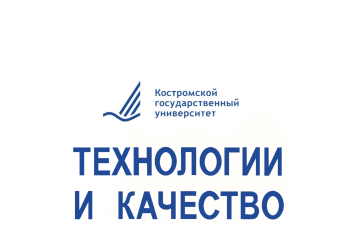- 7
- A MODEL OF THE WOVEN FABRIC ELONGATION AND BREAKING WITH INFLUENCE OF WARP AND WEFT THREADS UNEVENNESS AND INTERACTION
- Sevostyanov P. A., Monakhov V. I., Samoilova T. A., Vakhromeeva E. N., Zenzinova J. B. A model of the woven fabric elongation and breaking with influence of warp and weft threads unevenness and interaction. Technologies & Quality. 2021. No 3(53). P. 41–47. (In Russ.) https://doi.org/10.34216/2587-6147-2021-3-53-41-47.
- DOI: https://doi.org/10.34216/2587-6147-2021-3-53-41-47
- УДК: 677.022.2:519.876.5:519.248:004.942
- Publish date: 2021-08-18
- Annotation: The article presents the results of development of the woven fabric rectangular sample stretching and tearing computer simulation model. The model allows to set the sample size, elastic modulus and tensile breaking strength of the threads, random variations of these indicators for the warp and weft threads along their length. The modelling algorithm provides for the breakage of the warp threads, the redistribution of stress and strain between the sections of the threads and allows to get a detailed picture of the fabric sample deformation dynamics before it breaks. Examples of modelling results, the influence of the interaction degree between two systems of threads on the features of the strain distribution over the sections of the warp threads are given. The similarity of the simulation results according to the developed algorithm and the finite element method is shown, and the advantages of the proposed algorithm are noted.
- Keywords: woven fabric, stretching, rupture, unevenness, warp and weft relationship, computer model, statistical simulation, rupture dynamics
- Literature list: 1. Nikolaev S. D., Martynova A. A., Yuhin S. S., Vlasova N. L. Methods and instruments of Technological Processes Researches in Weaving*. Moscow, MGTU after A. N. Kosygin, 2003. 336 p. (In Russ.) 2. Sevostyanov P. A. Computer Models in Mechanics of Textile Materials. Moscow, Tiso Print, 2013. p. 254. (In Russ.) 3. Lomov S. V., Truevtzev F. V., Cassidy C. A Predictive Model for the Fabric-to-Yarn Bending Stiffness Ratio of a Plain-woven Set Fabric. Textile Research Journal. 2000;70(12):1088–1096. 4. Szablewski P. Estimating engineering constants of a selected model of textile composite. Indian Journal of Fibre & Textile Research. 2015;40,Sept.:236–242. 5. Ghane V., Lari V. Z. Estimating the deflection of weft yarn in plain woven fabric using yarn pull out test. Indian Journal of Fibre & Textile Research. 2014;39,Dec.:394–400. 6. Ezazshahabi N., Tehran M. A., Latifi M., Madanipour K. Modelling of surface roughness based on geometrical parameters of woven fabrics. Indian Journal of Fibre & Textile Research. 2017;42,March:43–50. 7. Singh M. K., Behera B. K. Effect of residual extensibility of polyester filament yarn on low-stress mechanical properties of fabric. Indian Journal of Fibre & Textile Research. 2018;43,March:53–58. 8. Alam Md. S., Majumdar A., Ghosh A. Role of fibre, yarn and fabric pa-rameters on bending and shear. Indian Journal of Fibre & Textile Research. 2019;44,March:9–15. 9. Velumani A., Kandhavadivu P., Parthiban M. Influence of blend pro-portion on mechanical properties of banana/cotton blended knit fabric. Indian Journal of Fibre & Textile Research. 2021;46,March:41–47. 10. Zamyshlyaeva V. V., Smirnova N. A., Lapshin V. V. Analysis of Methods of Determination of Textile Materials Stiffness in Elongation. Izvestiya Vysshikh Uchebnykh Zavedenii. Seriya Teknologiya Tekstil'noi Promyshlennosti [Textile Industry Technology (Series Proceedings of Higher Educational Institutions)]. 2009;4(318):10–12. (In Russ.) 11. Sevostyanov P. A., Tikhomirova M. L. Friction among the Threads of Weaving Fabrics during their Elongation. Tekhnologiya i kachestvo [Technologies & Quality]. 2019;3(45):22–27. (In Russ.). 12. Sevostyanov P. A., Samoilova T. A., Monakhov V. V. Finite element modelling of nonuniformity in the strain distribution for warp yarns in fabrics. Fibre chemistry. 2019;50,5:473–476. 13. Sevostyanov P. A., Samoilova T. A. Model and energy aspects for propagation of strain and mechanical stresses in textile fabrics. Fibre chemistry. 2018;50,2:108–110. 14. Sevostyanov P. A., Samoilova T. A. Computer Model of the Breaking Process of Woven Fabric during One Dimensional Elongation with Method of Statistical Dynamics. Izvestiya Vysshikh Uchebnykh Zavedenii. Seriya Teknologiya Tekstil'noi Promyshlennosti [Textile Industry Technology (Series Proceedings of Higher Educational Institutions)]. 2020;1(385):197–202. (In Russ.) 15. Primachenko B. M., Prohorova I. A. The Influence of the Structural Parameters on stiffness of the Cotton Fabric during Elongation*. Izvestiya Vysshikh Uchebnykh Zavedenii. Seriya Teknologiya Tekstil'noi Promyshlennosti [Textile Industry Technology (Series Proceedings of Higher Educational Institutions)]. 1987;2:106–108. (In Russ.) 16. Sevostyanov P. A. About the Regularity of the Location of the Weft in the Fabric. Izvestiya Vysshikh Uchebnykh Zavedenii. Seriya Teknologiya Tekstil'noi Promyshlennosti [Textile Industry Technology (Series Proceedings of Higher Educational Institutions)]. 1971;2:89–92. (In Russ.). 17. Sevostyanov P. A. The relationship between yarn unevenness and fabric unevenness. Izvestiya Vysshikh Uchebnykh Zavedenii. Seriya Teknologiya Tekstil'noi Promyshlennosti [Textile Industry Technology (Series Proceedings of Higher Educational Institutions)]. 1971;4:95–98. (In Russ.). 18. Sevostyanov P. A., Samoilova T. A., Monahov V. V. Warp Strain Distribution and Influence of Weft on it with Simulation of Warp Elongation in Fabrics. Izvestiya Vysshikh Uchebnykh Zavedenii. Seriya Teknologiya Tekstil'noi Promyshlennosti [Textile Industry Technology (Series Proceedings of Higher Educational Institutions)]. 2018;3(375):163–165. (In Russ.)



